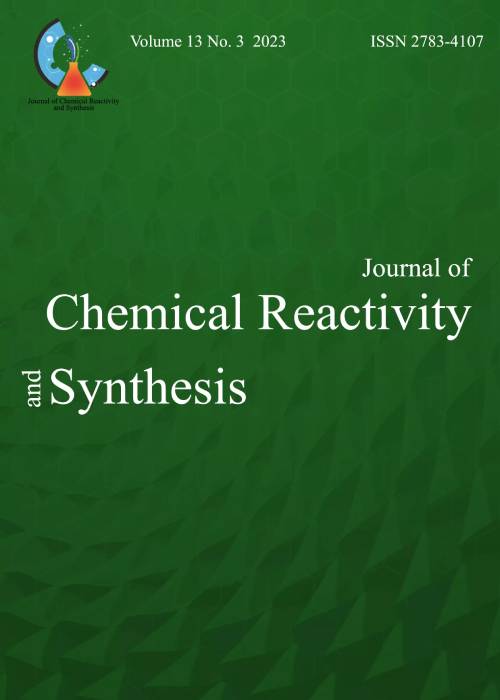فهرست مطالب
Journal of Chemical Reactivity and Synthesis
Volume:10 Issue: 3, Summer 2020
- تاریخ انتشار: 1398/06/10
- تعداد عناوین: 6
-
Pages 94-100
Calcined vanadium phosphorus oxide (VPO) prepared by an organic method is found to be an active and effective catalyst for the oxidation of various alkanes such as cyclohexane, n-hexane and cycloheptane in acetonitrile solvent using the environmentally benign oxidant, tert-butyl hydroperoxide, where the oxidation mechanism is believed to involve a reversible V4+/V5+ redox cycle. This heterogeneous catalyst at the end of the reaction is easily separated by the least cost of the product. This reaction is investigated in a polar and nonpolar solvent with different dielectric constant. Cobalt metal is also used as a catalyst enhancer and TBHP as an oxidizing agent. After catalytic tests and determining the best catalyst and ideal amount of cobalt percent improvement, detection and analysis will be done by analyzing XRD, SEM, TGA, IR.
Keywords: Cyclohexane, VPO Catalyst, TBHP, Acetonitrile -
Pages 101-107
In this research, effects of Na+ ion on Nitrogenous Organic Bases (NOB) in the nucleic acids by using of a new index. This index is according to Electric Field Gradient (EFG) in the middle of bond and evaluated as a reference by corresponding cyclic same compounds. The studied molecules were Adenine, Guanine, Cytosine, Thymine and Uracil that has been investigated. The trend of changes of aromaticity by putting Na+ in the middle of cycle and change of distance according to degree of Angstrom (Å). It has been used Density Functional Theory (DFT) as a method for geometrical optimization Beck 3 Lee Yang Parr (B3LYP) in 6-311++G** and 6-31G standard basis set. These calculations have been done in two steps. In the first step, it has been calculated electric field gradient in the middle of bond in absence of Na+ (EFG0) and in the second step in presence of Na+, it has been calculated in 1Å distance of middle of bond without Na+ (EFG0.5) and with Na+ that compared amount of aromaticity between EFG0 and EFG0.5 in 6 distance (d = 0.5, 1, 1.5, 2, 2.5 and 3 Å).
-
Pages 108-113
The present study focuses on the development of an effective methodology to obtain the optimum removal conditions assisted by ultrasonic to maximize the simultaneous removal of Bismarck Brown (BB) and Thymol Blue (TB) dyes on to TiO2 nanoparticles loaded on activated carbon (TiO2 -NPs-AC) in aqueous solution using response surface methodology (RSM). The experimental equilibrium data were fitted to the conventional isotherm models such as Langmuir, Freundlich, Temkin and Dubinin–Radushkevich. The Langmuir isotherm was found to be the best model for the explanation of experimental data.From the Langmuir isotherm, the maximum monolayer capacity (Qmax) was found to be 100 and 50 mg g-1 for BB and TB, respectively at optimum conditions. Kinetic evaluation of experimental data showed that the BB and TB adsorption processes followed well pseudo-second-order.
Keywords: TiO2 -NPs-AC, Dye, Central composite design, response surface methodology, Ultrasonicated adsorption -
Pages 114-124
The β-CD-DZ inclusion complex was prepared via freeze-drying method and characterized by using various spectroscopic techniques. The phase solubility diagram and Job plot showed the formation of a soluble complex of AL type (1:1 stoichiometric IC) with improved solubility and stability. The thermodynamic parameters for the β-CD-DZ IC formation were determined and analyzed on basis of involved driving forces. The results showed the reaction process in mainly entropy driven and endothermic that assigned the predominant role of hydrophobic interaction in the formation of β-CD-DZ complex. In conclusion, a comprehensive computational study has been done on formation process of β-CD-DZ IC using molecular docking methods. In case of β-CD-DZ IC, the results of thermodynamic parameters, molecular docking confirmed stable complex formation between β-CD-DZ and also DZ included into a narrow site of inner cavity of β-CD.
Keywords: β-Cyclodextrin (β-CD), Daidzein (DZ), 1H-NMR, inclusion complex (IC), Molecular docking -
Pages 125-132
In this work, the liquid-liquid equilibria (LLE) of (PEGDME2000 +ammonium sulphate + water) was studied at T= (298.15, 308.15 and 318.15) K. Furthermore for this system the free energies, enthalpies and entropies of cloud points were calculated at the mentioned temperatures in order to investigate the driving force for the mentioned two-phase system. For representing the experimental binodal data the Merchuk equation in the original form and with the temperature dependency and an empirical equation were used. Othmer-Tobias and Bancraft, a temperature dependent Setschenow and osmotic virial equations were used to fit the tie-line data. Moreover, the effect of temperature on the binodal curves and the tie-lines for the investigated aqueous two-phase system have been studied. In addition the partitioning behaviour of the lactic acid molecule on the investigated aqueous two-phase system was studied.
Keywords: Liquid–liquid) equilibrium, Polyethylene glycol di-methyl ether, Ammonium sulphate, Setschenow equation, lactic acid -
Pages 133-140
The Excited state reaction coordinates and the consequent energy profiles of a new Schiff Base N- Salicylidene-2-Bromoethylamine (NSBA) have been investigated at the CC2 level of theory. The electron-driven proton transfer and torsional deformation have been identified as the most important photochemical reaction coordinates. The potential energy profiles of the ground and the lowest excited singlet state are calculated. In contrast to the ground state, the excited state potential energy profile shows a barrier-less dissociation pattern along the O–H stretching coordinate which verifies the proton transfer reaction at the S1 (ππ*) state. The calculations indicate S1/S0 conical intersections (CIs) which provide non-adiabatic gates for radiation-less decay to the ground state. At the CI, barrier-free reaction coordinates direct the excited system to the ground state of enol-type minimum. According to calculation results, a trans- keto type structure obtained from photoexcitation of the enol, can be responsible for the photo chromoic effect of title compound. Furthermore, our results confirm the suggestion that aromatic Schiff Bases are potential candidates for optically driven molecular switches.
Keywords: Schiff base, Intramolecular Proton Transfer, Photo chromism


